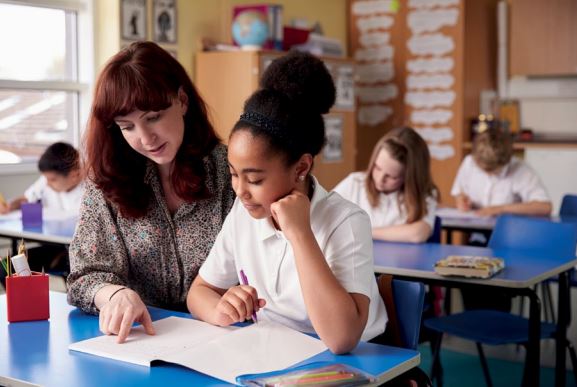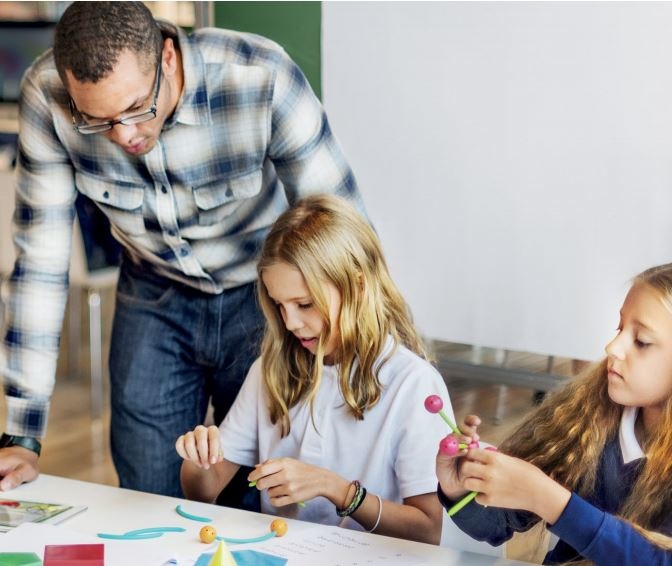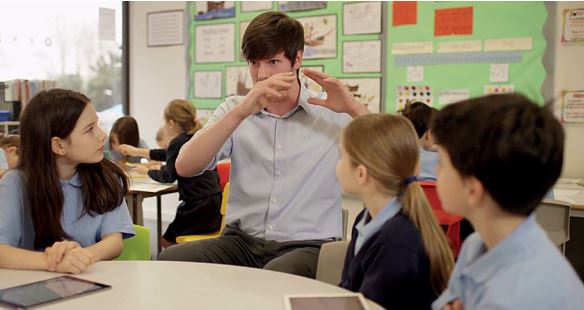
Do you know an avid reader who hates English class? A teenager who is both a marvelous writer and a hopeless procrastinator? It certainly isn’t easy to decode children’s behavior, but for gifted children, and especially twice exceptional children (gifted children with learning disabilities), the code can be especially hard to crack. Teachers who are attuned to the possibility of their students’ giftedness, who understand what makes gifted children tick, can avoid a frustrating tug-of-war and help their students’ creativity thrive. But first – what does the term “gifted” really mean?
Nathan Levy, author of the children’s book There Are Those, writes, “there are those, and they are few, who see…so much more…than others do.” Gifted educator Christine Nobbe seconds this definition: “Sometimes I’ll think giftedness is a construct. Then I’ll get to know a student, and I’ll think, yes – gifted. You know when it you see it,” she says. The behavior ranges: many high-achieving gifted students ask challenging questions of the teacher -- even to the point of seeming rude -- and demonstrate a strong willingness to redo assignments, always asking for more. Low-achieving gifted students may read a book in a day but struggle with task completion and projects. Many gifted students have high verbal acuity and a precocious sense of humor. Twice-exceptional students may have a passionate interest in a single subject with a tendency toward mismatched scores in reading or math. Emotionally, gifted children are subject to depression, anxiety, perfectionism, over-excitability and emotional intensity. They often lean toward introversion and a tendency to experience the world intuitively. Above all, “learning motivates gifted kids, not education. They generally aren’t impressed by grades or scores,” says gifted educator Dr. Robin Lady.
Jane Piirto, Ph.D., author of Talented Children and Adults, acknowledges that there is still “wide confusion about concepts of giftedness, talent and intelligence,” and points out that in the United States, there have been several attempts starting in the early 1970s to move beyond IQ score as the primary means of identification. For example, former commissioner of US Office of Education Sidney Marland has suggested that beyond intellectual giftedness, students can be gifted in specific academic, creative, leadership, artistic and/or psychomotor areas. Despite the variety of gifts and talents that children possess, intelligence researchers have proven that general intelligence – known as “the big g” – plays an important role in the articulation of more specific talents. The bottom line, according to Dr. Piirto, is that students who manifest gifted characteristics in school “have a right to an education that is differentiated according to these characteristics.”
Dr. Lady echoes this sentiment: “we have construed the word gifted to make it sound elite – it’s not – it’s receiving an education at your level. In the United States, we are required to differentiate for students on the other end...” According to a report issued by the Missouri Department of Elementary and Secondary Education, “universal screening,” in which all students in a specific grade level are systematically assessed for gifted characteristics, is one way to provide more equitable means of identification. The report also suggests a “20 percent equity index rule” for participation in gifted programs by minorities, to allow for cultural differences and voluntary exclusion – in other words, if 40 percent of an elementary school is English Language Learners, 32 percent of the school’s gifted students should be ELLs. The report offers detailed methods for fairly identifying poor and minority students, including multiple selection criteria, better teacher training to recommend these students and the re-testing of students who don’t meet legal criteria but demonstrate strong potential. For general education teachers who do not have an established gifted program in their school, Dr. Lady suggests identifying the top five percent of academic achievers, assuming they need more, and modifying instruction accordingly.

So what does instruction for gifted students look like? Gifted educator Dr. Felicia Dixon points out that “in gifted education, we say that our strategies are good strategies for everybody, and necessary strategies for gifted students.” Here are some strategies that will help you meet the needs of your gifted students, while likely improving your instruction for all:
Problem-Based Learning
According to Edutopia, problem-based learning is a subset of project-based learning. The two “PBLS” are more similar than different, and benefit gifted students by being student-centered and requiring high level thinking skills. As education consultant Thom Markham puts it, PBL “reverses the equation between skills and content.” Dr. Dixon outlines four steps to PBL:
1. Give students an authentic, engaging problem. One way to do this is to have students observe problems in the school environment. You can also set up an artificial scenario in your classroom.
2. Students inquire and investigate in small groups -- the longest stage in the process. Students arrive at a clearer problem definition and consider ways to solve it, but they should not be left solely to their own devices. Science teacher Fred Warren suggests that the best way to help gifted students who want to be fully independent is to express enthusiasm for what they’re doing, in essence, “geeking out with them.”
3. Students decide how they want to present a problem and its resolution.
4. Debrief: talk to students about what they learned and why problem-based learning was meaningful.
The design-thinking model provides another, helpful way to think about structuring a problem-based unit. Design thinking offers five essential steps:
1. Identify and empathize with your target audience
2. Define the problem and craft a mission statement
3. Brainstorm a variety of solutions
4. Create a prototype
5. Test the prototype and solicit feedback.
If you’re looking for ways to implement PBL, Dr. Dixon recommends what’s called “post-holing”: find a place in your existing curriculum to try PBL. PBL can last a mere few weeks, depending on your plans.
For more information about PBL, look for articles by William Stepien and Shelagh Gallagher. Another resource is the Buck Institute for Education, or bie.org.
Questioning Techniques
A simple way to improve teaching for all learners is to reflect on the level of questioning in your classroom. “Teachers control the minimum level of thought in their classrooms by the kinds of questions they ask,” says Dr. Dixon.
According to Bloom’s Revised Taxonomy, questions ascend in difficulty from 1-6:
1. Remember
2. Understand
3. Apply
4. Analyze
5. Evaluate
6. Create
To ensure that you’re asking higher-level questions, Dr. Dixon recommends the following steps:
1. Brainstorm questions freely, without evaluating them
2. Evaluate your questions ➝ what are your learning objectives?
3. Decide how you want to use your questions. Are you trying to deepen understanding? Establish understanding in the first place? Further discussion?
4. Order your questions and prepare for how you will respond if a student jumbles the order
5. Ask your questions!
6. Self-reflect ➝ what kinds of answers did you receive? Did students understand your questions? Did you need to frequently clarify or restate them?
Mr. Warren suggests “crossovers”: asking students to relate two concepts that are only vaguely about the same topic. Warren also points out that it’s relatively easy to turn lower level questions into higher ones by rephrasing and inserting the words why or how. For example, “What leads to macro evolution?” becomes “How does natural selection lead to macro evolution?” “You’re telling them what you want them to know and asking them why it’s the answer, so you’re going up on Bloom’s Taxonomy very quickly,” Warren says.
Ms. Nobbe suggests teachers memorize, and/or post, a few high-level question stems to use in class. You can find good question stems on the state of Illinois’s website by googling “Revised Bloom’s Taxonomy question starters.” If all else fails, Ms. Nobbe recommends pretending you’re a three-year-old and continually asking why during class discussions!

Refocus on Critical Thinking
Gifted students may especially benefit from teachers who push them to think more deeply. As stated by Richard Paul in the journal, Compass Points, “because of their brightness and the fact that they are praised for what they say and do, [gifted students] often become flashy rather than deep.”
One popular framework for promoting deep thinking is the notion of “accountable talk.” “Accountability” refers to:
2. Knowledge ➝ using relevant examples to support arguments, pushing each other to cite evidence, clarifying terms, determining what information is relevant
3. Rigorous thinking ➝ asking questions that test concepts, identifying personal bias, using sound analogies, challenging each others’ hidden assumptions
Practice accountable talk through Socratic seminars -- formal class discussions. They can be used in any discipline. English teachers Anna Sobotka and Amber Murphy push their students to be “accountable” by setting up Socratics in the following way:
- Students prepare for the seminar in writing.
- Students learn the difference between probing and clarifying questions via examples and must ask probing questions.
- Students respond to each others’ questions thoughtfully, “digging for answers rather than shooting out answers,” says Sobotka.
- Students use the text in critical ways, referring to specific quotes, moments or pages to justify their answers or deepen their questions.
- Students reflect on the quality of the discussion. Using a fishbowl format, students who are not in the discussion group take notes on the discussion -- for example, analyzing discussion points that changed the way they thought about the book.
- Students receive teacher feedback. For example, they might be praised for referring to the book in their examples, but be reminded to open and use their books when other students are citing examples.
Compacting
According to Joseph Renzulli and Sally Reis, “curriculum compacting might best be thought of as organized common sense.” In essence, it allows teachers to determine which students have already mastered content and design enrichment opportunities to engage and challenge those students instead. Compacting requires three basic steps:
1. Determine learning goals and outcomes ➝ this is typically done for you. Whether you are using a published curriculum or designing the curriculum yourself, you should have already identified the learning objectives you want students to achieve.
2. Identify candidates for compacting ➝ Renzulli and Reis point out that being an advanced learner “does not necessarily mean that a student knows the material under consideration,” so the most equitable solution is to pretest all students. To create appropriate pretests, Renzulli and Reis suggest using end-of-unit assessments as pretests, which should be ready at the beginning of a unit.
3. Provide Enrichment Opportunities ➝ According to Renzulli and Reis, “the final phase of the compacting process can be one of the most exciting aspects of teaching because it is based on cooperative decision making and creativity on the parts of both teachers and students.” Work with students to determine what projects challenge and interest them. This co-planning “is a creative opportunity for an entire faculty to work cooperatively… A favorite mini-course that a faculty member has always wanted to teach, or serving as a mentor to one or two students…can add excitement to the teachers’ part,” write Renzulli and Reis.
Clearly, compacting requires dedication, effort and time on the part of a classroom teacher, but as Renzulli and Reis point out, it can be very exciting to create customized enrichment activities. Generally speaking, compacting increases student engagement, and it’s much more rewarding to teach when students view your content as purposeful and meaningful.
Centers
Centers are another way to differentiate. According to Teacher Vision, there are three types of centers:
1. Enrichment centers “offer students a variety of learning alternatives as an adjunct to a common unit of instruction.” For example, an enrichment center might supplement a lesson on the life cycle of plants with observing different plants under a microscope or writing creatively about the uses/misuses of plants in modern society.
2. Skill centers, or stations, allow students to develop specific skills “after the initial teaching of a concept or a skill.” According to Mr. Warren, “stations almost always go well – they’re too high energy not to.” Mr. Warren tries to “switch the type of thinking” at each station, transitioning from a kinetic activity to a writing activity to a talking activity... He uses a timer and allocates his time either according to which station has the most complicated instructions or which group needs the most one-on-one attention.
3. Interest centers, also known as learning centers, “capitalize on the interests of students” and “provide students with hands-on experiences they can pursue at their own pace and level of curiosity.” For example, you might have an interest center about graphic novels in a language arts classroom. Or you might design one center with several unrelated activities, creating one multi-purpose space in your classroom where gifted learners can retreat. Or, as Dr. Robin Lady explains, “you might have a Lego center for students that like to build, a center of computers for kids that want to program, a Socratic seminar center for a book study, a center for math games…” With this model, you can design entire lessons around multiple learning centers.
Despite the work involved, centers provide a fun way to more deeply engage all learners, while meeting the basic needs of gifted learners.

Grouping
Cluster grouping -- grouping by ability -- is another important strategy. It’s the opposite of the mixed ability grouping that is taught in many mainstream education programs. According to Nobbe, mixed ability grouping often “ends up with the gifted student serving as the teacher.”
According to educational consultant Thom Markham, there’s a vast difference between “group work” and “teamwork.” Whereas groups “sit together, talk, plan and work,” teams collaborate to achieve shared outcomes. Markham recommends setting aside time to establish a team ethic during a project and before a project. For example, have students discuss their strengths and weaknesses, identify their commitments to each other, “mine for conflict” and celebrate their successes via “hang out time.”
According to Markham, “specific team roles work very well for younger students or when first starting teamwork based projects. But the next step is to help students choose and define their own roles as they get better at teamwork. Much more important than roles is to use good rubrics.” A sample rubric created by Markham emphasizes:
1. Work ethic ➝ bringing required materials, focusing during class, completing homework, minimal absences
2. Attitude and demeanor ➝ encouraging cooperation through words and actions, demonstrating a positive attitude, being non-disruptive
3. Team member performance ➝ being emotionally sensitive to others on the team, attempting to be inclusive, adapting easily to change
Markham also suggests creating a distinction between flexible working groups and teams. “Not every element of every project requires a team. A working group might come together for a research task,” he says.
If gifted students express a preference for working by themselves, Nobbe advises teachers to stress the real-world importance of working in groups.
For more information about cluster grouping, see The Cluster Grouping Handbook by Susan Winebrenner, M.S., and Dina Brulles, Ph.D.
In general, the biggest take away for classroom teachers is that it’s worth dedicating effort and time toward differentiating for gifted learners. In fact, it’s a matter of educational equity. As Dr. Lady puts it, “gifted in no way means better than; learning-disabled in no way means less than.” At the same time that gifted children have “unlimited potential and a love of learning,” says Dr. Lady, they also “have exceptionalities that are not always beneficial.” Dr. Dixon recalls teaching a gifted student who had clearly never been required to read in his English classes. “Somehow he eked out a grade and wasn’t reading anything,” she says. “When a student thinks their giftedness can get them through without doing stuff, the teacher has to catch that,” Dr. Dixon cautions. On the other hand, some gifted students are voracious readers but don’t like to work. To this point, Dr. Lady tells teachers “to give gifted students choices, but hold them accountable to their choices. They have to produce something with their gifts,” she says.
Perhaps the best starting point for a general education teacher with a large, diverse group of students is to encourage them all to identify and develop their talents. According to The Piirto Pyramid of Talent Development, talent is developed via six layers: genetic attributes, personality attributes, intelligence, specific talents, passion and finally, environment. Paula Wilkes, the coordinator for gifted education at Pacific University-Eugene Campus, led her full-inclusion classroom of 34 fourth and fifth graders repeatedly back to the pyramid to encourage them to locate and develop their gifts. For example, students identified relevant personality words that described them – e.g., self-discipline, resilience, imagination -- colored their “environmental suns,” (identifying where they received support for their gifts), researched magazine and newspaper articles in which successful adults typified aspects of the pyramid and revisited their self-identified personality attributes in academic self-assessments. The pyramid became a framework for parents as well.
Far beyond the transmission of content, it could be argued that a teacher’s primary role in a child’s life is to develop their talent. Let’s find all the ways we can, for as many students as possible. As Dr. Lady says, “these are the kids that are going to change the world.”
Ginger O’Donnel is a teacher and writer.
Knowledge trails
1. Buzzing on Drama – Sheli Blackburn, Armed with a mysterious bag, the contents of a bakery and the story of The Giant Jam Sandwich, Sheli Blackburn reveals how she captivated a group of gifted and talented children with a drama day to remember. http://library.teachingtimes.com/articles/ctl31p4651buzzingondrama
2. Gifted and Talented – Time for a Rethink – Barry Hymer presents some rather uncomfortable findings about intelligence and achievement, and believes that it is time for a re-appraisal of these concepts. http://library.teachingtimes.com/articles/gifted-and-talented-time-for-a-rethink
3. A View from the Head’s Room – The Gifted and Talented Agenda – Mike Kent, I often think that if Johnathan Swift was alive, he’d have a field day satirising the nonsense that cascades from the DfES and into our schools. http://library.teachingtimes.com/articles/a-view-from-the-heads-room
4. Inspiring the Gifted and Talented – Debs Hughes, In this, the first of a two-part article, Debs Hughes offers advice on how to inspire and motivate gifted and talented children. http://library.teachingtimes.com/articles/inspiring-the-gifted-talented
5. Inspiring the Gifted and Talented (Part 2) – Debs Hughes continues her article on how to inspire and motivate gifted and talented children. http://library.teachingtimes.com/articles/inspiring-the-gifted-and-talented-part-2
References
1. Nathan Levy, There Are Those
2. Christine Nobbe, Gifted Educator, nobbechristine@gmail.com
3. Dr. Robin Lady, Gifted Educator, ladyrobin@rsdmo.org, robin.lady.gam@gmail.com
4. Jane Piirto, Ph.D., Talented Children and Adults
5. MO Department of Elementary and Secondary Education, Identifying and Serving Traditionally Underrepresented Gifted Students
6. Dr. Felicia Dixon, Gifted Educator, fdixon@bsu.edu
7. Edutopia: Project-Based Learning vs. Problem-Based Learning X-BL
8. Fred Warren, High School Science Teacher, frederickmwarren@gmail.com
9. Anna Sobotka, High School English Teacher, assobotka@gmail.com
10. Curriculum Compacting: A Systematic Procedure for Modifying the Curriculum for Above Average Ability Students
11. Teacher Vision: Learning CentersThom Markham, Educational Consultant, thom@thommarkham.com